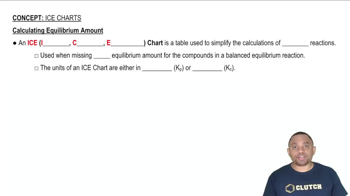Here are the essential concepts you must grasp in order to answer the question correctly.
Chemical Equilibrium
Chemical equilibrium occurs when the rates of the forward and reverse reactions are equal, resulting in constant concentrations of reactants and products. In this state, the system is dynamic, meaning that reactions continue to occur, but there is no net change in concentration. Understanding this concept is crucial for analyzing equilibrium constants and predicting the behavior of reactions.
Recommended video:
Chemical Equilibrium Concepts
Equilibrium Constant (Kc)
The equilibrium constant (Kc) quantifies the ratio of the concentrations of products to reactants at equilibrium for a given reaction at a specific temperature. For the reaction SO2Cl2(g) ⇌ SO2(g) + Cl2(g), Kc = [SO2][Cl2]/[SO2Cl2]. A small Kc value, like 2.99 * 10^-7, indicates that at equilibrium, the concentration of reactants is much greater than that of products, suggesting that the reaction favors the reactants.
Recommended video:
Equilibrium Constant Expressions
ICE Table (Initial, Change, Equilibrium)
An ICE table is a tool used to organize the initial concentrations, changes in concentrations, and equilibrium concentrations of reactants and products in a chemical reaction. By setting up an ICE table for the given reaction, one can systematically determine the equilibrium concentrations based on the initial conditions and the equilibrium constant. This method simplifies the calculations needed to find unknown concentrations at equilibrium.
Recommended video:
ICE Charts and Equilibrium Amount
 Verified step by step guidance
Verified step by step guidance


